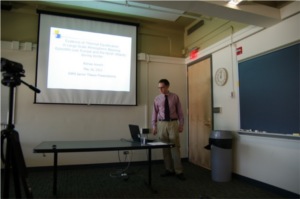PAOC Spotlights
2012 Senior Theses
For her Senior Thesis Deepa Rao has been working with graduate student Laura Meredith to understand the microbially-mediated soil H2 sink while fellow PAOC unergraduate Roman Kowch worked with Lodovica Illari looking at the thermodynamics of atmospheric blocking. Read on to savour a taste of each of their projects:
Exploring the Microbially-mediated soil h2 sink: A lab-based study of the physiology and related H2 consumption of isolates from the harvard forest Leaf litTER
Deepa Rao (ADVISOR LauRA Meredith)
 Last summer, Deepa isolated soil microorganisms with a remarkable ability to scavenge H2 from the atmosphere. In her experiments, she has found interesting relationships between H2 utilization and the organisms' developmental stage and physical structure. Her results add to our understanding of the underlying processes that drive the largest sink for atmospheric H2.
Last summer, Deepa isolated soil microorganisms with a remarkable ability to scavenge H2 from the atmosphere. In her experiments, she has found interesting relationships between H2 utilization and the organisms' developmental stage and physical structure. Her results add to our understanding of the underlying processes that drive the largest sink for atmospheric H2.
Approximately 80% of molecular hydrogen in the lower atmosphere is taken up by a soil sink, which is largely controlled by H2-utilizing microbes. Understanding factors such as how a microbe's life cycle affects its h2 uptake activity can help us understand and demystify the largest and least understood term in Earth's atmospheric hydrogen budget.
Deepa recieved this year's Christopher Goetze Prize for Undergraduate Research - given "in recognition of innovative experimental design, care in data collection, and sensitive application of results to research problems.
This fall, Deepa heads to Georgetown University to begin two-year masters program in Culture, Communication, and Technology. Combining her love for art and science, her goal is to "create educational science media for the masses".
Evidence of thermal equilibration in large-scale atmospheric blocking episodes over Europe and the North Atlantic during Winter
Roman Kowch (ADVISOR Lodovica Illari)
 Blocking dipoles are responsible for most of extreme winter weather over Western Europe. Roman has investigated whether blocking patterns have the signature of thermally equilibrated states. The work was inspired by the observation that winter blocking episodes tend to occur in the eastern Atlantic and anchor themselves over surface temperature anomalies, with the blocking high over the warm ocean surface and the accompanying cut off low over the cold land. Using reanalysis data, Roman was able to show that wintertime blocking composites have indeed the hallmark of thermally equilibrated modes, with low diabatic heating and calm surface winds. A preliminary investigation of summer blocking events has confirmed their tendency to align themselves with surface temperature anomalies.
Blocking dipoles are responsible for most of extreme winter weather over Western Europe. Roman has investigated whether blocking patterns have the signature of thermally equilibrated states. The work was inspired by the observation that winter blocking episodes tend to occur in the eastern Atlantic and anchor themselves over surface temperature anomalies, with the blocking high over the warm ocean surface and the accompanying cut off low over the cold land. Using reanalysis data, Roman was able to show that wintertime blocking composites have indeed the hallmark of thermally equilibrated modes, with low diabatic heating and calm surface winds. A preliminary investigation of summer blocking events has confirmed their tendency to align themselves with surface temperature anomalies.
Roman's junior project, also working with Lodovica Illari, was concerned with visualizing the atmospheric polar front - you can read more about that work in last year's spotlight Visualizing Earth Science Data.
Roman returns to PAOC this fall to begin a 5th year masters in atmospheric science.
PAOC congratulates both seniors for their hard work and looks forward to following their graduate careers with interest.